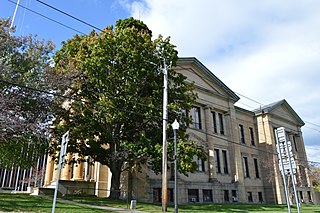
The Townsend Home is a historic house located about 3 miles (4.8 km) from Stockton, Illinois, in Jo Daviess County. It is a fine example of an Upright and Wing style house with Greek Revival detailing and was completed in 1856. The house was listed on the U.S. National Register of Historic Places in 2005.

The Albert Kahn House is located at 208 Mack Avenue in Midtown Detroit, Michigan, within the Brush Park district. It is currently the headquarters of the Detroit Urban League. The house was designated a Michigan State Historic Site in 1971 and listed on the National Register of Historic Places in 1972.

Ward House, also known as the William Allen House, is a historic home located at Westfield in Chautauqua County, New York. It is a 2-story, L-shaped brick Italian Villa–style residence built in the late 1860s. The home features a prominent cupola, and the property has a 1 1⁄2-story frame barn.

House at No. 30 Murray Street is a historic home located at Mount Morris in Livingston County, New York. It was built about 1890 and is a textbook example of the late 19th century interpretation of the Queen Anne style. It features asymmetrical massing, decorative shingle siding, multi-gabled roof with tall corbelled brick chimneys, and a prominent corner tower.

House at No. 8 State Street is a historic home located at Mount Morris in Livingston County, New York. It is believed to have been built in the 1850s. The Italianate style building features cubic massing, a prominent cupola, tripartite projecting bay windows, and a profusion of decorative woodwork.

Sliker Cobblestone House is a historic home located at Conesus in Livingston County, New York. It consists of a 1 1⁄2-story frame structure with a 2-story visually dominant cobblestone portion and 1-story rear shed addition. It features medium-sized field cobbles set in horizontal rows in its construction. The interior features Federal-style details. Also on the property are four contributing outbuildings: a shed, four privies, and a barn dating to about 1900.
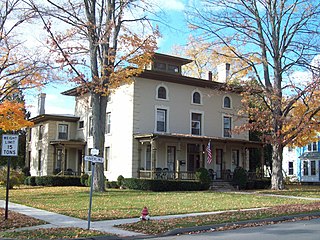
Sedgwick House is a historic home located at Bath in Steuben County, New York. It was built between 1840 and 1854 and is a 2 1⁄2-story Italianate style brick dwelling coated with stucco. The low pitched hipped roof features a prominent cupola.

Capt. Simon Johnston House, also known as Kemp House, is a historic home located at Clayton in Jefferson County, New York. It was built in 1880-1882 and is a 2 1⁄2-story frame Italianate style residence. The main facade features an engaged central tower extending one story above a low pitched hipped roof. The tower features a pagoda style roof.

Gen. Walter Martin House is a historic home located at Martinsburg in Lewis County, New York. It was built in 1805 and consists of the original two story, hip roofed, stone Federal main block with Greek Revival wings added about 1835. The front features a projecting center pavilion surmounted by a triangular pediment. It was the home of General Walter Martin (1766–1834), founder and namesake of the town of Martinsburg.

The Gerald–Dowdell House is a historic Italianate style house in Montgomery, Alabama. The two-story frame and masonry raised-cottage was built in 1854–55 for Perley and Camilla Gerald. Perley Gerald was born in New York and migrated to Alabama in 1829. The house was added to the National Register of Historic Places on April 28, 1980. It was extensively restored in 2000 and now houses the law offices of Wilkerson and Bryan, P.C.

Fraser-Hoyer House is a historic home located at West Haverstraw in Rockland County, New York. It was built about 1812 and is a two-story, five bay, rectangular frame dwelling with a hipped roof and stone foundation. It features Federal style details.

Isaac M. Haswell House is a historic home located at Colonie in Albany County, New York. It was built in 1880 and is a two-story farmhouse in the Italianate style. It features a one-story porch with ornate brackets, finials, and carved rope decorations.

George W. Denton House is a historic home located at Flower Hill in Nassau County, New York. It was built in 1873 and is a rectangular, 2-story wood frame building with a two-stage rear service ell in a vernacular Italian Villa style. It features a 2 1⁄2-story engaged tower, semi-octagonal bay windows, and an "L" shaped wraparound verandah. Also on the property is a brick ice house built into the side of a hill.

House at 19 Locust Place is a historic home located at Sea Cliff in Nassau County, New York. It was built in 1893 and is a large, rambling 2 1⁄2-story house with slate-covered cross-gable roof and a large round tower in the Shingle Style. It features a broad shed-roofed wraparound porch supported by Doric order columns and a variety of window types.
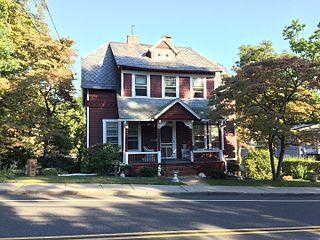
House at 199 Prospect Avenue is a historic home located at Sea Cliff in Nassau County, New York. It was built about 1890 and is a two-story house with decorative slate jerkinhead roof in the Late Victorian style. It features a three bay shed roof dormer that forms the second floor and covers the entrance porch. It is identical to the House at 195 Prospect Avenue.
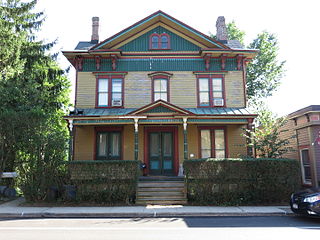
House at 285 Sea Cliff Avenue is a historic home located at Sea Cliff in Nassau County, New York. It was built in 1884 and is a 2 1⁄2-story clapboard house with a square plan and cross-gabled roof in the Italianate style. It features deep overhanging eaves with decorative scrollsawn brackets and round arched windows.

Mapleton, also known as Alumnae House, College of White Plains, is a historic home located at White Plains, Westchester County, New York. It was built in 1867 and is a large, 2 1⁄2-story five-bay residence with Second Empire and Italianate-style design details. It features a large verandah, a central pavilion tower capped with a small dome, and a mansard roof with slate tiles. Also on the property is a polygonal frame gazebo. From 1894 to 1925, it housed the convent of the Sisters of the Divine Compassion. In 1925, the house was acquired for academic use. It was owned by the College of White Plains, which merged with Pace University in 1976.
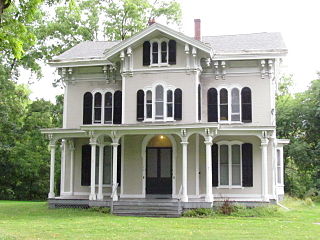
Rombout House is a historic home located at Poughkeepsie, Dutchess County, New York. It was built about 1854 on land that had been part of the original British royal Rombout Patent of 1685 and is a 2 1⁄2-story, three-bay-wide, Hudson River Bracketed architectural style dwelling. It sits on a raised basement and features a central pavilion. It has been owned by Vassar College since 1915.

Banks-Mack House is a historic home located at Fort Mill, York County, South Carolina. It was built about 1871, and enlarged and renovated in the Classical Revival style in 1910. It is a two-story, frame dwelling with a one-story, hip roofed wraparound porch. The porch once encompassed a large hickory tree that was removed because of damage from Hurricane Hugo in September 1989.

Mack-Belk House is a historic home located at Fort Mill, York County, South Carolina. It consists of a one-story rear section built in the 1860s, with a two-story, three bay, brick main block built about 1890. It features a one-story, hip roofed wraparound porch with Late Victorian design elements.

